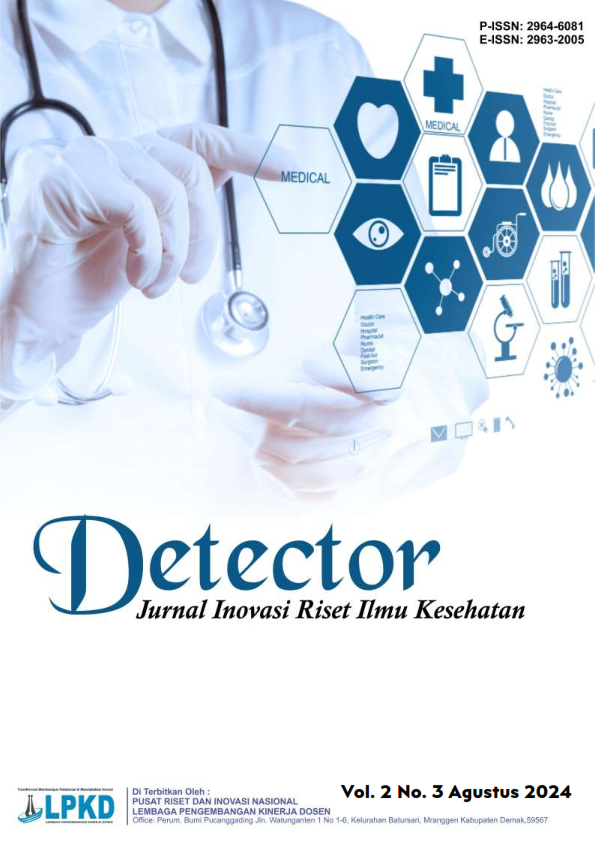Uji Kelayakan Alat Pelindung diri Lead Apron di Instalasi Radiologi Rumah Sakit Daerah Mangusada Badung
DOI:
https://doi.org/10.55606/detector.v2i3.4240Keywords:
Lead apron, Testing, Radiographic method, Lead apron leakAbstract
Lead apron is a type of personal protective equipment in the form of an apron and made of lead which is designed to protect the body from the dangers of radiation. Menurut Keputusan Menteri Kesehatan Republik Indonesia Nomor 1250/MENKES/SK/XII/2009 regarding Quality Control Guidelines to protect the density and physical condition of the lead apron, testing is required once a year and may be carried out before one year if necessary. To maintain the quality of the lead apron, it needs to be stored in a good manner and avoid stacking and folding it. Because it can cause damage which will reduce its function as radiation protection equipment. Lead apron storage should be stored flat without folds or on a special shelf. The aim of this research is to test lead aprons in the Radiology Installation of Regional Hospitals Mangusada Badung to determine the feasibility of the lead apron. The type of research used is descriptive quantitative research with a survey approach, observation, namely by carrying out testing, measurement and documentation. This research was conducted in July. The results of this study indicate that lead apron testing in the Radiology Installation of Regional Hospitals Mangusada Badung What has been done is that the four lead aprons are still in good condition and still suitable for use.
Downloads
References
BAPETEN. (2020). Keselamatan radiasi dalam penggunaan pesawat sinar-X radiologi diagnostik dan intervensional (Perka BAPETEN No. 4 Republik Indonesia).
Fatimah, N., & Siti, M. (2017). Pengujian lead apron dengan menggunakan metode radiografi di Instalasi Radiologi RSUD Bendan Kota Pekalongan.
Hiswara, E. (2015). Buku pintar proteksi radiasi dan keselamatan radiasi di rumah sakit. Jakarta: BATAN Press.
Indrati, R., Masrochah, S., Susanto, E., Kartikasari, Y., Wibowo, A. S., Darmini, A. B., & Rasyid, M. E. (2017). Proteksi radiasi bidang radiodiagnostik dan intervensional. Magelang: Inti Medika Pustaka.
Kartikasari, Y., Fathoni, M. A. N., & Indrati, R. (2018). Uji fungsi alat pelindung radiasi (Lead Apron) di Instalasi Radiologi Rumah Sakit lin Naliska 4. In Seminar Nasional SDM Teknologi Nuklir, Yogyakarta (pp. 374-384).
Kementerian Kesehatan Republik Indonesia. (2009). Keputusan Menteri Kesehatan Republik Indonesia Nomor 1250/MENKES/SK/XII/2009, Pedoman Kendali Mutu (Quality Control).
Lakhwani, O. P., Dalal, V., Jindal, M., & Nagala, A. (2018). Radiation protection and standardization. Journal of Clinical Orthopaedics and Trauma, 10(4), 738-743.
Lambert, K., McKeon, T. (2001). Inspection of lead aprons; Criteria for radiation protection.
Nikmawati, A., & Masrochah, S. (2018). Evaluasi performance lead apron. JRI (Jurnal Radiografer Indonesia, 1(2), 104-109.
Oyar, O., & Kislalioglu, A. (2012). How protective are the lead aprons we use against ionizing radiation. Diagn Interv Radiol, 18(2), 147-152.
Downloads
Published
How to Cite
Issue
Section
License
Copyright (c) 2024 Detector: Jurnal Inovasi Riset Ilmu Kesehatan

This work is licensed under a Creative Commons Attribution-ShareAlike 4.0 International License.








